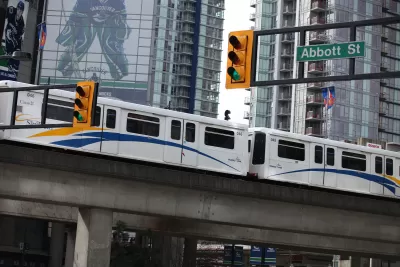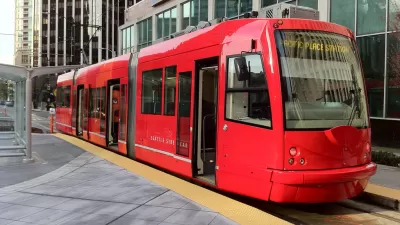Many jurisdictions need additional funding to improve, or just maintain, their public transport services. A timely new study evaluates eighteen potential funding options according to eight criteria.

Travel demands – how and how much people want to travel – are changing. Demographic and economic trends (aging population, rising fuel prices, increasing urbanization, change consumer preferences, increasing health and environmental concerns, etc.) are causing automobile travel to peak, and demand for alternative modes to increase. Although few motorists want to give up driving altogether, at the margin, that is, compared with their current travel patterns, many people want to drive less and rely more on walking, cycling and public transport, provided those modes are convenient, comfortable and affordable. Such investments can provide high economic returns: each dollar spent improving walking, cycling and public transit can provide several dollars in total savings and benefits.
As planners, it is our responsibility to help communities respond to these changing demands. This helps create efficient and equitable transportation systems which allow travellers to choose the most efficient mode for each trip. Virtually everybody benefits if communities accommodate this growing demand for resource efficient travel modes; even people who do not currently use transit benefit from reduced traffic and parking congestion, increased safety, reduced chauffeuring burdens, and by having the option available if needed in the future. As a result, walking, cycling and public transit improvements are a major portion of most urban region’s strategic transportation plans.
There is one major problem: inadequate funding. A major portion of current transport funds are dedicated to roads and parking facilities, and will be needed for future roadway maintenance. Some revenue sources, such as fuel and sales taxes, have declined, leading to transit funding crises. As a result, many planners, public officials and advocates in many cities (for example, Vancouver, Seattle and Toronto) are currently searching for new transportation funding.

Vancouver has plans to expand SkyTrain transit service - but needs money to do so.
My article, Evaluating Public Transportation Local Funding Options (which summarizes a somewhat more detailed report), recently published in the Journal of Public Transportation, is therefore timely. It evaluates eighteen potential transit funding options according to eight criteria (potential revenue, predictability and sustainability, horizontal and vertical equity, travel impacts, strategic development objectives, public acceptance and ease of implementation). This is a somewhat larger set of options and more detailed and systematic evaluation than most previous studies of this type. The table below summarizes the results.
Name |
Description |
Advantages |
Disadvantages |
|
Fare increases |
Increase fares or change fare structure to increase revenues |
Widely applied. Is a user fee (considered equitable). |
Discourage transit use. Is regressive. |
|
Discounted bulk passes |
Discounted passes sold to groups based on their ridership |
Increases revenue and transit ridership |
Increases transit service costs and so may provide little net revenue |
|
Property taxes |
Increase local property taxes |
Widely applied. Distributes burden widely. |
Supports no other objectives. Is considered regressive. |
|
Sales taxes |
A special local sales tax |
Distributes burden widely. |
Supports no other objectives. Regressive. |
|
Fuel taxes |
An additional fuel tax in the region |
Widely applied. Reduces vehicle traffic and fuel use |
Is considered regressive. |
|
Vehicle fees |
An additional fee for vehicles registered in the region |
Applied in some jurisdictions. Charges motorists for costs. |
Does not affect vehicle use. |
|
Utility levy |
A levy to all utility accounts in the region |
Easy to apply. Distributes burden widely. |
Is small, regressive and support no other objectives. |
|
Employee levy |
A levy on each employee within a designated area or jurisdiction |
Charges for commuters. |
Requires collection system. May encourage sprawl if only in city centers. |
|
Road tolls |
Tolls on some roads or bridges |
Reduces traffic congestion. |
Costly to implement. Can encourage sprawl if only applied in city centers. |
|
Vehicle-Km tax |
A distance-based fee on vehicles registered in the region |
Reduces vehicle traffic. |
Costly to implement. |
|
Parking taxes |
Special tax on commercial parking transactions |
Is applied in other cities. |
Discourages parking pricing and downtown development. |
|
Parking levy |
A special property tax on parking spaces throughout the region |
Large potential. Distributes burden widely. Encourages compact development. |
Costly to implement. Opposed by suburban property owners. |
|
Expanded parking pricing |
Increase when and where public parking facilities (such as on-street parking spaces) are priced |
Moderate to large potential. Distributes burden widely. Reduces driving. |
|
|
Development or transport impact fees |
A fee on new development to help finance infrastructure, including transit improvements |
Charges beneficiaries. |
Limited potential. |
|
Land value capture |
Special taxes on property that benefit from the transit service |
Large potential. Charges beneficiaries. |
May be costly to implement. May discourage transit-oriented development. |
|
Station rents |
Collect revenues from public-private development at stations |
Charges beneficiaries. |
Limited potential. |
|
Station air rights |
Sell the rights to build over transit stations |
Charges beneficiaries. |
Limited potential. |
|
Advertising |
Additional advertising on vehicles and stations |
Already used. |
Limited potential. Sometimes unattractive. |
This table summarizes potential funding options identified in this study.
Currently, the most widely used transit funding sources include fares, property taxes, sales taxes, fuel taxes, advertising and station rents. There may be potential to increase revenues from some of these options, although fare increases contradict other planning objectives. Fuel tax increases and expanded parking pricing are particularly appropriate because they also encourage more efficient transport in addition to raising revenues. However, these taxes and fees are considered burdensome and regressive (their actual regressivity depends on the quality of transport options available, and so is reduced by public transit service improvements) and so should be implemented gradually.
The options that seem most acceptable to the public (development and transportation impact fees, station rents and advertising) tend to generate modest revenue. Economists are particularly enthusiastic about congestion pricing, but it tends to be costly and politically difficult to implement, and total revenues are often modest since tolls are only collected on a small portion of total vehicle travel.
Three new revenue options with significant potential deserve more consideration: parking levies (special property taxes on non-residential parking spaces throughout the region), vehicle levies (an additional fee on vehicles registered in the region) and employee levies (a levy on each employee, often only collected from larger employers). These could generate relatively large amounts of revenue, distribute costs broadly, and have a logical connection to transit improvements (high quality transit benefit motorists, businesses and employees). These three options have moderate implementation costs, more than increasing existing transit funding options, but less than road tolls or vehicle-mileage fees.
Land value capture taxes and levies should also be considered. They should be structured to avoid discouraging transit-oriented development (they should not be too high or geographically concentrated), and it may be best to defer their implementation for a few years until station-area demand rises sufficiently. It is particularly appropriate to create local area benefit districts around transit stations where modest special levies and parking meter revenues are used primarily to finance local improvements such as station amenities, streetscaping and special cleaning and security services, rather than financing system-wide transit services.
This research discovered no new funding options that are particularly cost effective and easy to implement: each option has disadvantages and constraints. As a result, this study’s overall conclusion is that a variety of funding options should be used to help finance the local share of public transit improvements to ensure stability (so total revenues are less vulnerable to fluctuations in a single economic sector or legal instrument) and distribute costs broadly.
For More Information
APTA (2012), Primer on Transit Funding, American Public Transportation Association (www.apta.org).
CTOD (2011), Transit and Regional Economic Development, Center for Transit Oriented Development (www.ctod.org/portal).
Kevin DeGood (2012), Thinking Outside the Farebox: Creative Approaches to Financing Transit Projects, Transportation for America.
Rodrigo Diaz and Daniel Bongardt (2013), Financing Sustainable Urban Transport - International Review of National Urban Transport Policies and Programmes, Sustainable Transport in China, GIZ and Embarq.
ITF (2013), Funding Urban Transportation: A Case Study Compendium, International Transport Forum.
Todd Litman (2010), Raise My Taxes, Please! Evaluating Household Savings From High Quality Public Transit Service, Victoria Transport Policy Institute.
Todd Litman (2013), Evaluating Public Transit Benefits and Costs, Victoria Transport Policy Institute (www.vtpi.org); at.
Todd Litman (2014), “Evaluating Public Transportation Local Funding Options,”Journal of Public Transportation, Vol. 17, No. 1, 2014, pp. 43-74.
Stephen L. Reich, Janet L. Davis and Braden Sneath (2012), Florida MPOAC Transportation Revenue Study, Center for Urban Transportation Research for the Florida Metropolitan Planning Organization Advisory Council.
Ko Sakamoto, Stefan Belka and Gerhard P. Metschies (2010), Financing Sustainable Urban Transport, GTZ Sourcebook Module, Sustainable Urban Transport Project (www.sutp.org) Asia and the German Technical Cooperation.
Jeffery J. Smith and Thomas A. Gihring (2003), Financing Transit Systems Through Value Capture: An Annotated Bibliography, Geonomy Society.
TISAP (2013), Making the Move: Choices and Consequences, Transit Investment Strategy Advisory Panel.
TransLink (2012), TransLink Funding Options Website.
TRB (2011), Equity of Evolving Transportation Finance Mechanisms, Special Report 303, Transportation Research Board.
UTCM (2010), A Guide to Transportation Funding Options; Transit Funding – Summary of Funding Strategies, University Transportation Center for Mobility, Texas Transportation Institute.

Trump Administration Could Effectively End Housing Voucher Program
Federal officials are eyeing major cuts to the Section 8 program that helps millions of low-income households pay rent.

Planetizen Federal Action Tracker
A weekly monitor of how Trump’s orders and actions are impacting planners and planning in America.

Ken Jennings Launches Transit Web Series
The Jeopardy champ wants you to ride public transit.

California Invests Additional $5M in Electric School Buses
The state wants to electrify all of its school bus fleets by 2035.

Austin Launches $2M Homelessness Prevention Fund
A new grant program from the city’s Homeless Strategy Office will fund rental assistance and supportive services.

Alabama School Forestry Initiative Brings Trees to Schoolyards
Trees can improve physical and mental health for students and commnity members.
Urban Design for Planners 1: Software Tools
This six-course series explores essential urban design concepts using open source software and equips planners with the tools they need to participate fully in the urban design process.
Planning for Universal Design
Learn the tools for implementing Universal Design in planning regulations.
Ada County Highway District
Clanton & Associates, Inc.
Jessamine County Fiscal Court
Institute for Housing and Urban Development Studies (IHS)
City of Grandview
Harvard GSD Executive Education
Toledo-Lucas County Plan Commissions
Salt Lake City
NYU Wagner Graduate School of Public Service




























